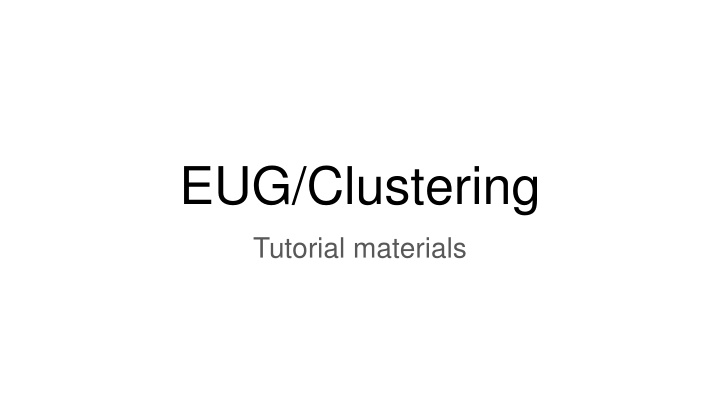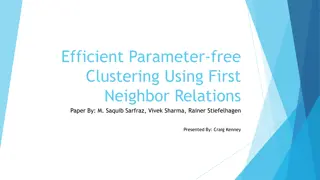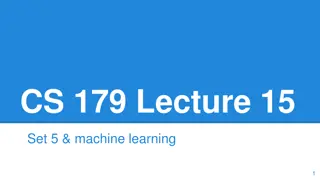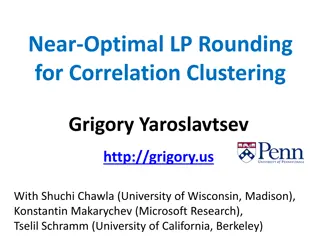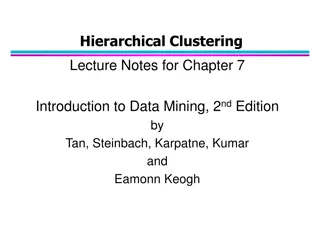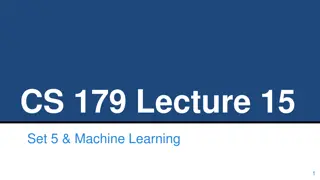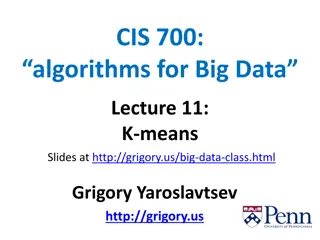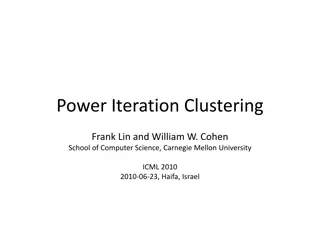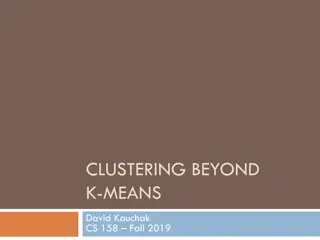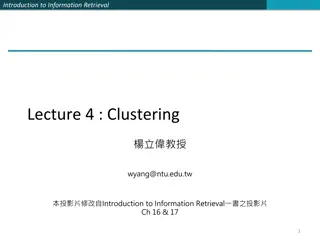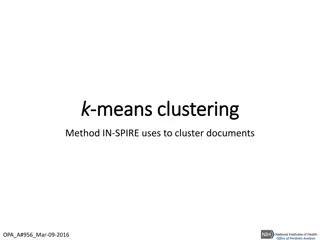Cluster Algorithms: K-Means Clustering and Selecting K
This tutorial covers k-means clustering algorithm, selecting the optimal number of clusters, and interpreting clustering results using visualizations. Learn how to determine the number of clusters and evaluate the quality of clustering solutions based on segregation, separation, and simplicity criteria.
Download Presentation

Please find below an Image/Link to download the presentation.
The content on the website is provided AS IS for your information and personal use only. It may not be sold, licensed, or shared on other websites without obtaining consent from the author.If you encounter any issues during the download, it is possible that the publisher has removed the file from their server.
You are allowed to download the files provided on this website for personal or commercial use, subject to the condition that they are used lawfully. All files are the property of their respective owners.
The content on the website is provided AS IS for your information and personal use only. It may not be sold, licensed, or shared on other websites without obtaining consent from the author.
E N D
Presentation Transcript
EUG/Clustering Tutorial materials
Cluster Algorithms In this study, you will learn about clustering algorithms, and then try to answer some questions interpreting them. The k-means clustering algorithm tries to identify if there are clusters of points in the data. A cluster is a set of points that are similar to one another, but dissimilar to points in other clusters. In the figure above, we see the data on the left. If we use k- means clustering with k=3, it finds the solution on the right. The k-means algorithm cannot determine how many clusters exist. You tell it k, the number of clusters you want to use, and it gives you the best solution.
Selecting k: The Number of Clusters Often, there is not one clear answer for what k should be The number of clusters is an INPUT to the k-means algorithm, not a output It is up to the analyst to decide which k is the best Sometimes, more than one solution can be reasonable There are several criteria for knowing whether the solution is good: The clusters should little overlap (segregation) There should be gaps between clusters (separation; Between/Within SS) The more clusters there are, we require stronger evidence (simplicity)
How many clusters are there? Which figure above represents the most optimal clustering results?
Two cluster result: The two subgroups are segregated (little overlap) No separation between clusters This shows an reasonable result.
How many clusters are there? Which figure above represents the most optimal clustering results?
Two Ks (clusters) result: We can see clear boundaries between bottom-left and upper- right subgroups (separation). We see no overlap (segregation) between two clusters. This shows an optimal result.
Three Ks (clusters) result: We can see overlap between green and red clusters which means no clear segregation between them. We see no clear boundary between green and red clusters, which means no clear separation between them. This shows a poor result.
How many Ks (clusters) to choose? Which figure above represents the most optimal clustering results?
Two Ks (clusters) result: 1. We can see clear boundary between blue and red clusters. 2. However, we can also see a clear boundary (separation) in blue cluster. 3. This shows an nonoptimal result.
Three Ks (clusters) result: 1. We see clear boundaries (seperation) among three clusters. 2. In addition, we see a clear boundary (separation) between green and blue clusters (these two clusters were one cluster in 2 Ks solution). 3. This shows an optimal result.
How many Ks (clusters) to choose? Which figure above represents the most optimal clustering results?
Two Ks (clusters) result: 1. We can not see very clear boundaries between green and red clusters. 2. We see a slightly overlap between two cycles. 3. We can see clear separation in green cluster (upper vs. lower points) 4. This shows an not optimal result.
Three Ks (clusters) result: 1. We can see no overlap among green, red, and blue clusters. 2. We see clear boundaries among three clusters. 3. However, we also see separation, quite clear boundary in green cluster, which means that it may be reasonable to separate green cluster. 4. This shows an ok but not optimal result.
Four Ks (clusters) result: 1. We can see no overlap among green, red, blue, and purple clusters. 2. We see clear boundaries among four clusters. 3. We also see clear boundary (separation) between green and red clusters (these two clusters were one cluster in three Ks solution), 4. This shows an optimal result.
